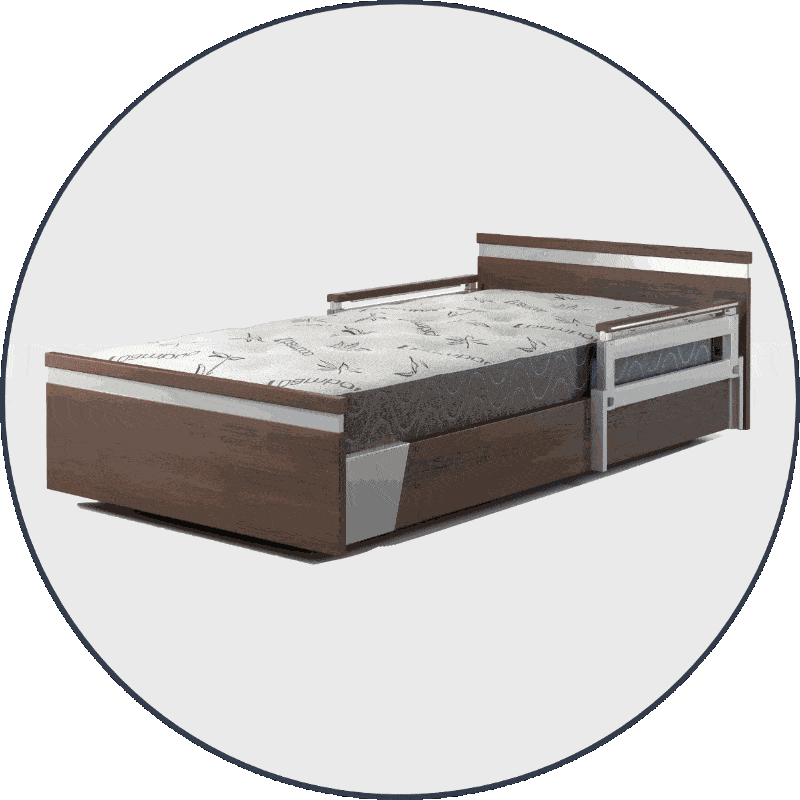Choosing the right hospital bed size can be tricky. Hospital beds are typically Twin XL, measuring 38 inches by 80 inches. This article will guide you on understanding hospital bed dimensions and ensuring bedding compatibility for patient comfort.
- Hospital beds are usually Twin XL, sized at 38 inches by 80 inches, to give taller patients more space and fit hospital rules better.
- Bedding must match the Twin XL size for patient comfort and to avoid problems like sheets coming off. It’s key in preventing health issues such as bedsores.
- When getting bedding for hospital beds, it’s important to measure the bed first, choose materials that prevent pressure sores, and pick sheets that are easy to clean.
Understanding Hospital Bed Dimensions

Hospital beds are often Twin XL size to fit in tight spaces and meet hospital rules. Knowing the size helps pick the right sheets and makes sure they fit well on the bed. In fact, SonderCare beds start at slightly larger than a Twin XL to give a bit more space to our customers without causing caregiver strain.
Twin XL beds in hospital settings
Twin XL beds in medical facilities measure 38 inches wide and 80 inches long. They offer more foot space than standard twin sizes, fitting well with adjustable frames used in healthcare.
These beds support taller patients comfortably and distribute weight evenly. Made from sturdy materials like stainless steel, Twin XLs meet the needs of those with medical conditions or mobility issues.
They reduce risks such as bed sores by providing adequate room and comfort.
Choosing the right bedding for these longer beds is crucial for patient care. Fitted sheets, mattress toppers, and pillows designed specifically for Twin XL dimensions ensure a snug fit and contribute to overall patient well-being.
Caregivers prefer this size because it adapts well to hospital regulations, accommodating a variety of body types and reducing the likelihood of pressure ulcers in bedridden patients.
Compliance with hospital regulations
Hospitals need to follow strict rules about bed sizes. These rules make sure patients stay safe and avoid problems like not being able to move around well or getting pressure ulcers.
The right size helps nurses and doctors take care of patients better, too. Beds must also fit the room in a way that lets healthcare workers do their jobs without trouble.
Choosing beds that meet these standards is important for patient comfort and makes the hospital run smoothly. Next, we look at why picking the right bedding for these beds matters just as much.
Importance of Bedding Compatibility
Making sure your bedding fits right on a hospital bed matters a lot. Picking Twin XL sheets helps everything stay comfy and works well with the bed’s design.
Choosing Twin XL specific bedding
Picking the right size bedding for hospital beds means choosing Twin XL specific sheets and covers. These beds are 38 inches by 80 inches, so standard twin sheets won’t fit. By selecting the exact size, you prevent issues like sheets coming off or being too tight, which can cause discomfort for the patient.
Twin XL bedding ensures a snug fit that stays in place, helping to keep patients comfortable and hygienic.
Using correctly sized Twin XL bedding also fights against health problems such as bedsores. Beds that have well-fitting sheets help in maintaining cleanliness and reducing pressure on sensitive areas of the patient’s body.
For those with adjustable beds or needing special care with medical equipment like wheelchairs or mobility devices near their sleeping area, Twin XL bedding is crucial. It allows ease of use without sacrificing comfort or safety.
Ensuring bedding compatibility with hospital beds
Ensuring bedding fits hospital beds right is key for patient care. The right size keeps the bed clean and safe.
- Measure the hospital bed before buying sheets. Twin XL is common, but check to be sure.
- Pick bedding that matches the Twin XL size to avoid issues with fit.
- Use materials like memory foam to prevent pressure sores and improve comfort.
- Check the weight capacity of both mattress and bed to match patient needs.
- For larger patients, choose bariatric hospital beds and compatible sheets.
- Look for high thread count sheets for more comfort without causing skin problems.
- Ensure the mattress supports medical needs, such as pain management or Alzheimer’s care.
- Select sheets that are easy to clean and change, which helps in maintaining hygiene.
- Consider waterproof protectors to safeguard the mattress from spills and stains.
- Verify that all bedding accessories, like bed skirts or comforters, also fit well.
These steps will keep patients comfortable while making sure their environment stays clean and supportive of their health.
Patient Comfort and Well-being
Choosing the right bed size and mattress affects how cozy a patient feels. Using Twin XL beds with soft mattresses helps patients rest better.
Impact of bed size on patient comfort
Choosing the right size for a hospital bed can greatly affect a patient’s comfort. Twin XL beds are ideal in hospital settings because they fit taller patients better, ensuring optimal ergonomic design.
This specific size helps prevent discomfort, reduced mobility, and pressure ulcers by minimizing the risk of pressure points on the body. Also, it supports proper spinal alignment and reduces muscle strain, which is crucial for patients spending long hours in bed.
A bed that fits the patient perfectly ensures optimal ergonomic design.
The right mattress material also plays a significant role in enhancing patient well-being.
Impact of mattress material on patient well-being
The material of a mattress plays a vital role in a patient’s health. Memory foam and medical-grade mattresses offer pressure relief and support. They help reduce pain, improve blood flow, and boost respiratory function.
A good mattress aids recovery for those in home hospital beds or undergoing surgeries.
Selecting the right mattress improves quality of life by enhancing sleep comfort and reducing discomfort from high BMI or surgeries. Fabrics used in these mattresses keep air moving to prevent hot spots and sweating, making the healing process faster for patients using twin mattresses or larger sizes like full size bed options in medical care settings.
Hospital beds mainly come in Twin XL size, measuring 38 inches by 80 inches. This size offers extra length for taller patients and fits well with hospital regulations. For patient care, choosing the right bed and bedding is critical.
Twin XL bedding ensures a perfect fit and promotes hygiene and comfort. In summary, understanding these dimensions helps select appropriate beds and bedding, enhancing patient comfort and meeting medical needs effectively.
The size of hospital beds varies, with some being twin size (3’3″) and others being full width (4’6″) or even longer (Kroonenbert, 1964). The choice of bed size is important, as it can impact patient comfort and the ability of caregivers to provide care (Wiggermann, 2017). However, the specific size of hospital beds, whether twin or twin XL, is not explicitly mentioned in the literature.

















